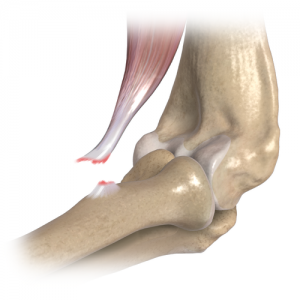Distal Biceps Tendon Injuries
The biceps tendon is a tendon in the elbow which helps with supination and elbow flexion. It attaches to the radial tuberosity in the proximal forearm. Distal biceps injuries typically occur in men (93%) in their 40’s and usually occur in the dominant arm (86%). A tear usually occurs after an eccentric load (elbow pulled against resistance into extension). Partial tears involving less than 50% of the tendon can be considered for non-operative treatment with rest. Although NOT mandatory, complete tears are often fixed in higher demand patients to prevent loss of strength. A discussion with your surgeon on whether or not to surgically fix the biceps tendon is important. Without surgery, one can expect a loss of strength of up to 50-60% with prolonged supination (i.e. repetitive turning of the screw driver). Even with surgery, there can be a loss of 20% of the original strength. Risks of surgery include nerve damage, fracturing the proximal radius, extensive bone growth at the repair site causing motion restrictions, persistent pain and weakness, and other complications. Thus, surgery should be considered after thorough understanding of the risks and benefits of the procedure.

Repair of the biceps is done through a single incision on the front of the arm (see video below and to the left). The tendon is located and a hole is drilled into the proximal radius at the native attachment site of the distal biceps tendon (radial tuberosity). Strong suture called fiberwire is then sewn into the tendon and the suture is threaded through a button that is dunked into the drilled hole. The sutures are then tensioned to pull the tendon into the bone socket and an anchor is then inserted into the same socket to secure the tendon in place. A knot is then tied over the anchor and the skin is closed.
After surgery, effort is given to minimize tension on the repair. You will be in a posterior long-arm splint until your initial evaluation in clinic. At this point, you will transition to a hinged elbow brace and start therapy. Gaining full extension is a process that happens over weeks as elbow extension and pronation (turning the palm down) puts tension on the repair. Also, actively engaging the biceps with elbow flexion and supination tensions the repair and these movements are avoided initially. Motion is initiated with passive range of motion (i.e. motion without muscle activation).
The following rehab protocol is to allow sufficient protection of the repair while the tendon heals back down to bone while at the same time preventing elbow stiffness. Your protocol may be modified by the surgical team to meet your specific needs. Below is a template for a distal biceps repair rehab protocol:
Phase One:
Goals – minimize swelling, maintain finger range of motion, and allow wound healing
Day Zero:
Keep the arm elevated with ice on the anterior portion of the elbow
Finger motion – both active and passive is instituted to prevent stiffness
Keep the splint clean and dry
Week 1-2:
At approximately 10 days postoperatively, a removable hinged elbow brace will be placed. This brace will typically be locked in 45 degrees of flexion based upon the intra-operative tension of the biceps
Begin passive flexion as well as passive forearm rotation
Wean from the pain medications and transition to Tylenol for pain
Phase Two:
Goals – gradually increase full passive range of motion while protecting the repair, in cases of more chronic biceps repair this protocol will be modified with less aggressive range of motion.
Week 3-6:
Week 3: Increase passive elbow extension by 15 degrees to 30 degrees lack of extension. Begin wrist extension, wrist flexion, radial deviation, and ulnar deviation as full finger motion and near full forearm rotation is obtained
Week 4: Increase passive elbow extension to 15 degrees lack of extension
Week 5 and 6: Goal of full extension by the end of the week. Continue only passive elbow motion and forearm rotation.
Phase Three:
Goals – begin active range of motion and initiate strengthening
Week 7-12:
Week 7: Begin active isometric strengthening of the shoulder muscles as well as the triceps
Week 8: Active range of motion of the elbow with no resistance can be initiated
Week 9-12: Begin single plane resisted active range of motion of elbow flexion, extension, supination and pronation. Start light with 2 pound weight and increase this by 3 pounds each week. The goal of strengthening is low weight with sets of 20-30 to produce fatigue but not to overstress the repair.
For Athletes: At week 13 sport specific training can be re-initiated on a supervised basis. Contact athletes can return to sport at 5 months postoperatively.
For Laborers: Work specific exercises are initiated and a resumption to full activity can be achieved by 4 months with protection against overloading up to 5 months postoperatively.
As with all surgery please call the clinic at 307-578-1955 if there are any concerns including abnormal redness or drainage around the wound,
fevers, chills, numbness, tingling or increasing pain.
This protocol can also be found under patient resources at openrangeortho.com
Definitions:
Passive Range of Motion – Motion across a joint without activating any muscles on either side of the joint. To do this either another person has to move the joint for you or you have to use the nonoperative arm to get motion.
Active Range of Motion – The joint is moved by the muscles crossing the joint. For example for the elbow, the biceps flexes the joint and the triceps extends the joint.
Supination – This is rotation of the forearm so the palm of the hand is facing upward.
Pronation – This is rotation of the forearm so the palm of the hand is facing downward.
